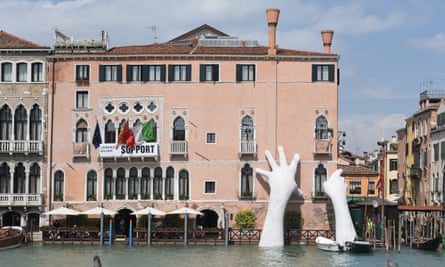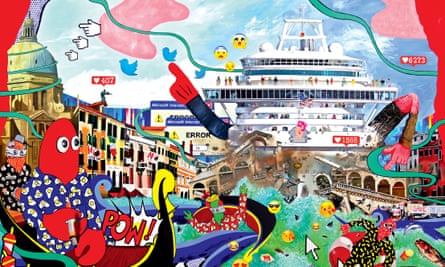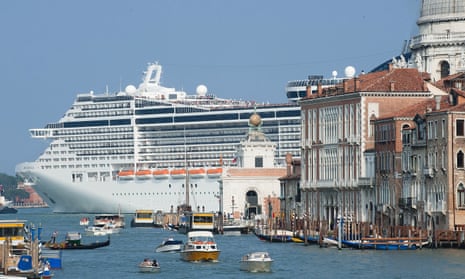A monster cruise ship meets a giant octopus and crashes into the Rialto bridge, provoking a tsunami. It’s an apocalyptic vision of Venice. The message of Stop the Madness, Philip Colbert’s pop-art-with-a-purpose at the current Venice Biennale, is echoed by Lorenzo Quinn’s Support, a large-scale installation of giant hands reaching out of the Grand Canal to prop up the crumbling Palazzo Sagredo.
Venice’s mayor Luigi Brugnaro could also do with a helping hand. Under-populated and over-touristed, Venice is facing threats from all sides. Its status as a world heritage site is slowly sinking, with Unesco threatening to slap the city on its in-danger list, a fate normally reserved for war-ravaged ruins, under-funded third world sites and, er, Liverpool. Unesco’s concerns about cruise ships, mass tourism and damage to the fragile lagoon ecosystem “have been met with empty promises but no concrete proposals”, according to Italia Nostra, the country’s influential heritage body.
For outsiders, megaships are the biggest blight, symptomatic of the vested interests that paralyse Venetian decision-making. For Jonathan Keates, chairman of Venice in Peril, the cruise ships “are an abomination whose size threatens the dimensions of the city”. Indeed, the World Monument Fund put Venice on its watch list in 2014 precisely because “large-scale cruising is pushing the city to an environmental tipping point and undermining quality of life for its citizens”.

Despite Unesco’s desired cruise ban, the city authorities are unapologetic about welcoming the vast ships into the lagoon. The city cruise association says that Venice keeps the entire Adriatic cruise industry afloat and provides 5,000 jobs. The eco-friendly option, to create a reversible cruise terminal outside the Lido entrance to the lagoon, was rejected. This response is viewed by many as part of a political mindset that puts short-termism before sustainability and misconceived big projects before an array of smaller but sounder projects.
Local associations pour scorn on the latest cruising “solution”, a cosmetic gloss to remove the ships from the St Mark’s sightline. Venetian activist Marco Gasparinetti slams the agreed route, which will see the re-opening of the Vittorio Emanuele channel in the polluted petrochemicals zone of Marghera, on the mainland: “The channel triples the current transit time for ships and increases exposure to toxic emissions, all to deposit passengers in the same cruise terminal, moored right by our homes.”
Environmental scientist Jane da Mosto concurs: “Cruise ships bring incompatibly large numbers of visitors but vested interests conspire to keep the terminal where it is, in the heart of historic Venice.” As head of the social enterprise We Are Here Venice, da Mosto is keen to raise awareness about safeguarding Venice and its lagoon: “Water is not Venice’s enemy, it is its soul. The passage of every single ship causes erosion of the mudflats and sediment loss.”

For environmental non-profits such as Venezia Nostra, re-opening the channel would be a backward step, with deep dredging in the delicate lagoon causing damage to the buffer zone designed to keep Venice safe. As it is, the cruise lines’ pledge to use cleaner, low-sulphur fuel is only as good as the ships’ willingness to respect the agreement and the authorities’ ability to monitor breaches.
En masse, we tourists are toxic, too. Venice, a city of 54,500 resident, receives 30 million visitors a year, of whom many are grab-and-go day-trippers. As hotelier Alessandro Possati of Bauer Hotels observes: “It’s ironic how for a timeless city no one has any time for her.” From bottlenecks on bridges to overflowing ferries and death-by-carnival clowns, La Serenissima feels anything but serene.
Still, making a city centre “pay-to-play” is a contentious issue and Italy’s tourism minister insists that “cities must stay open and free”. Paola Mar, Venice’s head of tourism, dismisses ticketing entry “with the conceivable exception of St Mark’s Square, should we find no alternative”. St Mark’s is the city’s biggest draw but the shopkeepers’ association rejects any such proposal, saying it would simply shift the crowds elsewhere. For now, rather than capping tourism, the city plans to monitor numbers at key hotspots. Longer term, the council favours incentivising pre-booking rather than imposing bans.

Tourism controls may be on the agenda but the city is timorous about bolder, revenue-raising measures, with funds used for conservation.
Local activists such as writer Michela Scibilia favour trialling a ticketing scheme to St Mark’s, with early bookers free but last-minute visitors made to pay. Instead, according to Paola Mar, immediate plans to manage tourism range from setting up designated picnic sites to the introduction of tourism police and a crackdown on unauthorised B&Bs. A tourist charter will be enforced, prohibiting picnics in St Mark’s, the feeding of pigeons and crowds blocking the bridges.
While the city authorities ponder pigeons and picnic sites, Venice is dwindling away. Around a thousand residents move to the mainland every year, unable to afford rapacious rents or find a niche beyond tourism.
“The culture of mass tourism is intolerable. The resident population has halved since the 1970s but if it falls below 40,000, Venice will not be a viable, living city any longer,” says Keates, who believes the solution is a long-term plan which favours residents but not buy-to-let businesses. “The plan should manage tourism, impose higher tourist taxes, introduce tax breaks for small businesses and favour affordable housing: Venice needs the feet of residents on the ground, children playing in the campi, old codgers on benches – a proper Italian city as we know it,” he adds.

As for Unesco’s verdict, the city authorities may well be sipping a spritz in the last chance saloon. The case for a final reprieve has been submitted to Unesco but remains secret because neither the Venetian authorities nor the Italian government wish their proposals to be open to scrutiny.
According to Lidia Fersuoch, head of the Venice chapter of Italia Nostra, blacklisting is the best option as “international oversight is the sole means of ensuring Venice’s survival”. But international embarrassment alone won’t resolve the issues. As Scibilia says: “Who wants to live in a city ‘at risk?’ We’re not going to attract new residents like that.”
Mose, the mobile flood barrier designed to save Venice from the sea, remains mired in controversy, with its completion date slipping to 2019. Corruption scandals aside, the project has dented Venetian morale and devoured funds of over £6bn, according to FAI, the Italian version of the National Trust.
Curiously, the fact that the city coffers are bare gives supporters of sustainable Venice some hope for salvation. Many citizens are campaigning for a separation from the mainland, to be determined by referendum in October. The mayor, largely elected with mainland votes, is challenging its legality. Given the much greater population of the Mestre (mainland Venice), the divergent interests of mainland Venetians are imposed on historic Venice. This time, the Venexiteers are in with a chance.
Ultimately, as Unesco says, “saving Venice means saving the Venetians”. Most Venice residents put their faith in an independent, internationally backed solution to averting this perfect storm. We are all custodians of this treasure. As Venice fan Vivienne Westwood has said: “If we can’t save Venice, we can’t save the world.”

Comments (…)
Sign in or create your Guardian account to join the discussion